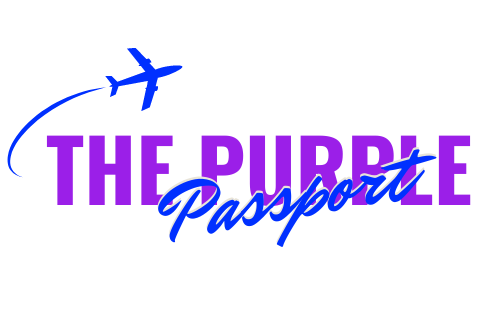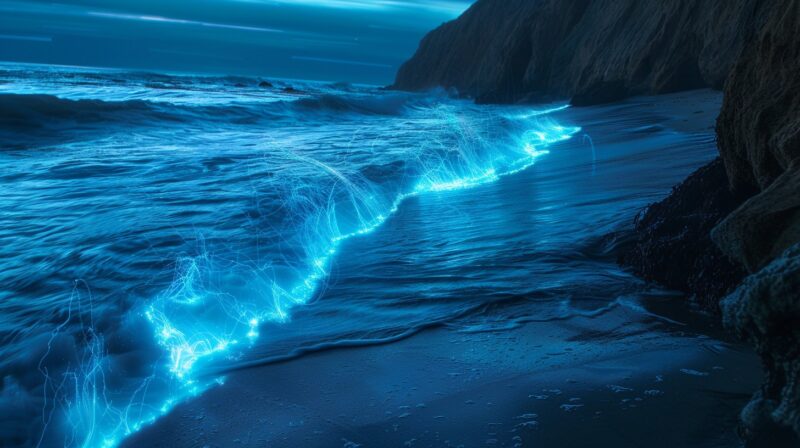Have you ever seen the ocean light up at night? Picture waves hitting the shore, glowing with this amazing blue light. It’s like magic! These bioluminescent waves happen because some algae in the water produce light through a chemical reaction. Southern California is one of the coolest places to see this natural wonder.
Let’s check out the best spots where you can catch this incredible show.
1. Laguna Beach
Laguna Beach is famous for its beautiful coastline and colorful marine life. Sometimes, the waves here light up at night with a magical blue glow. If you want to enjoy this in peace, find one of the quieter spots. Main Beach and Thousand Steps Beach are great for catching these glowing waves.
Local photographers love capturing the enchanting blue light, so it’s a popular spot for night shots. Make sure to check the tide schedules for the best times to see the bioluminescence.
2. Huntington Beach
Huntington Beach is known for its long pier and surf vibes. It’s also a fantastic place to see bioluminescent waves. The wide beach and consistent waves set the stage for an awesome light show.
Check out Sunset Beach and Bolsa Chica State Beach for the best views. Some local surf schools even offer night surfing when the waves are glowing! With lots of parking and amenities, it’s super easy to visit.
3. Newport Beach
Newport Beach is the perfect mix of city and nature. When the conditions are right, the waves here glow with a stunning blue light. It’s easy to get to, making it perfect for a nighttime outing. The area around Newport Pier is especially popular for these light shows.
4. Encinitas
Encinitas offers some of the best views of glowing waves. The beaches here aren’t as commercialized, so you get a more natural, intimate vibe. Check local reports to find out when the waves are glowing.
Moonlight State Beach and Swami’s Beach are local favorites. Plus, Encinitas has several beachfront parks where you can set up a picnic while you wait for the light show. The town’s laid-back atmosphere adds to the charm.
5. Cardiff State Beach
Just south of Encinitas, Cardiff State Beach is another great spot to see the glowing waves. The gentle waves and clear waters create the perfect conditions for bioluminescence. San Elijo State Beach, right next to Cardiff, is also a great spot. This area is popular with campers who stay a few nights to catch multiple evenings of glowing waves.
Local surf shops often have updates on the bioluminescence, so you can stay in the loop.
6. Tomales Bay in Marin County
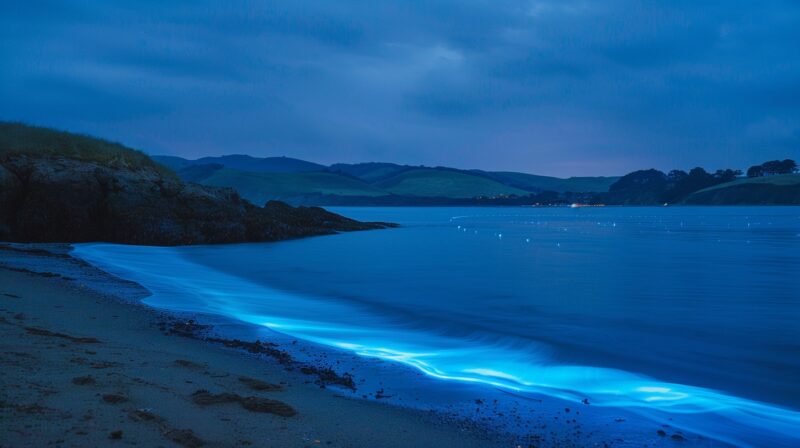
Tomales Bay might be a bit north of SoCal, but trust me, it’s worth the trip for the bioluminescent waves. This spot is famous for its glowing waters, especially during the summer. Imagine kayaking at night with the water lighting up around you – it’s surreal!
The bioluminescence here is super bright, making your paddles and wake glow. Local tour companies offer guided tours, so you’ll be safe and learn a lot. The peaceful, remote setting adds to the magic.
7. Santa Monica Bay
Santa Monica Bay is known for its iconic pier and lively vibe, but did you know it also has bioluminescent waves? The bay is huge, which means more chances to catch this cool phenomenon. To avoid the crowds, head to quieter spots like Malibu Lagoon State Beach or Will Rogers State Beach.
The city’s nightlife is a fun contrast to the natural light show on the water. Beachside parks in Santa Monica give you great views too.
8. Point Reyes in San Francisco
Point Reyes is another northern gem for seeing bioluminescent waves. The remote beaches here are perfect for viewing the glowing water. Check out Drakes Beach and Limantour Beach – they’re known for their bioluminescence. Plus, Point Reyes is a wildlife haven, making your visit extra special. With no city lights around, the bioluminescence really stands out.
9. Mission Beach in San Diego
San Diego is a prime spot for bioluminescent waves, and Mission Beach is one of the best places to experience them. The long sandy beach and gentle waves are perfect for the glowing algae. Before or after your nighttime visit, you can have some fun at Belmont Park right on the beach.
10. La Jolla Shores
La Jolla Shores is already famous for its stunning coastline and marine life, but it gets even better during the bioluminescent season. The waves here can put on a spectacular light show. There are marine research institutions nearby that often give updates on bioluminescence, so you can stay informed.
Scripps Institution of Oceanography studies this phenomenon and sometimes offers public lectures and tours. For a closer look at the glowing waters, try a kayaking tour in La Jolla Cove. Plus, the beach is conveniently close to downtown La Jolla.
11. Blacks Beach
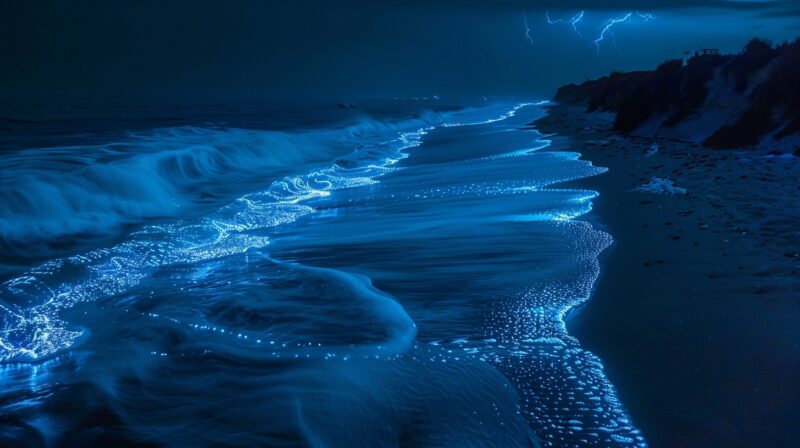
Blacks Beach is known for its breathtaking cliffs and secluded feel, making it a fantastic spot in San Diego to see bioluminescent waves. The isolation here is perfect for a quiet, awe-inspiring night. You’ll need to hike down some steep cliffs to get there, adding a bit of adventure to your trip.
The lack of light pollution makes the glowing waves even more impressive. Surfers often report the most vibrant displays during nighttime surf sessions.
What Are Bioluminescent Waves?
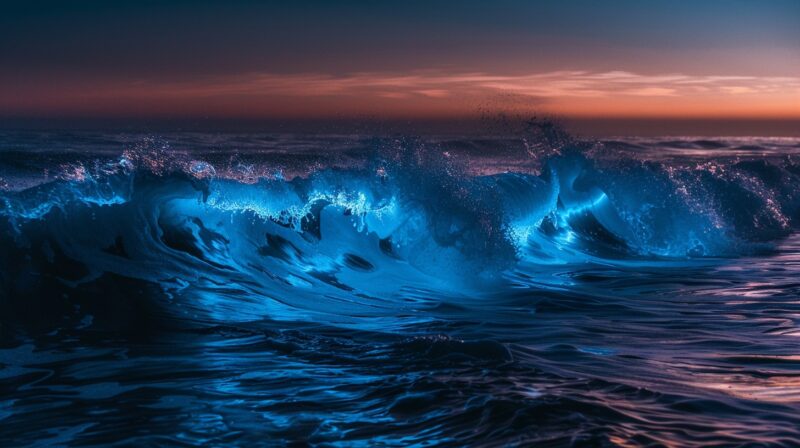
Bioluminescent waves are a visual phenomenon where the ocean lights up at night. This happens because of high concentrations of algae in the water, particularly a type of plankton called dinoflagellates. When these tiny organisms are disturbed by the motion of the waves, they emit a blue-green light. This chemical process is called bioluminescence.
How Do They Form?
Bioluminescence occurs in many marine organisms, including fish, squid, crustaceans, and algae. These creatures use bioluminescence for various reasons, such as confusing predators, attracting prey, or finding mates.
When Do They Appear?
Bioluminescent waves are most commonly seen in the spring or fall months. In Southern California, you can expect to see them from late spring through early fall, although they have been observed as early as February and as late as December. The best time to witness this phenomenon is during the night when the glow is most visible.
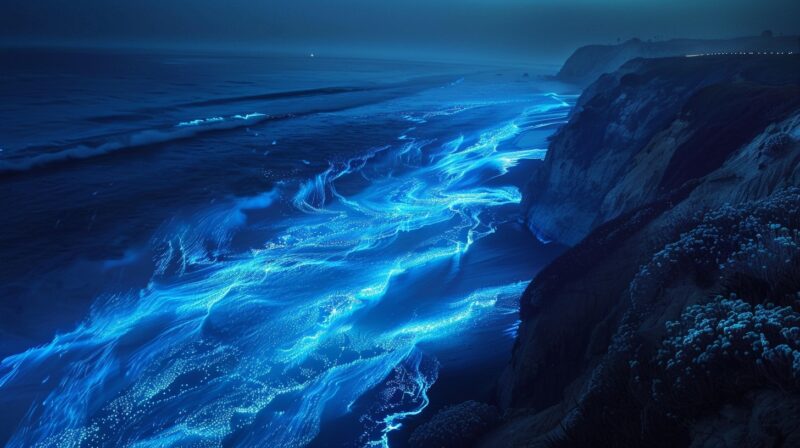
Safety Considerations!
While watching bioluminescent waves is safe, swimming in them requires some caution. The organism Lingulodinium polyedra, responsible for the glow, can produce yessotoxin, a neurotoxin. However, local populations in San Diego do not contain this toxin.
Despite this, it’s best to be cautious, as the effects of yessotoxin are not fully understood and may cause genotoxicity. Additionally, red tides, which are elevated levels of dissolved particle matter, can turn the water reddish and increase microbial activity. Therefore, while it’s safe to watch bioluminescence, swimming is at your discretion.
Final Thoughts
Seeing bioluminescent waves is like witnessing a real-life fairytale. The way the ocean lights up under the night sky is unforgettable. So, grab your friends and family, head to one of these incredible spots, and get ready to be blown away by the glowing wonders of the sea.
